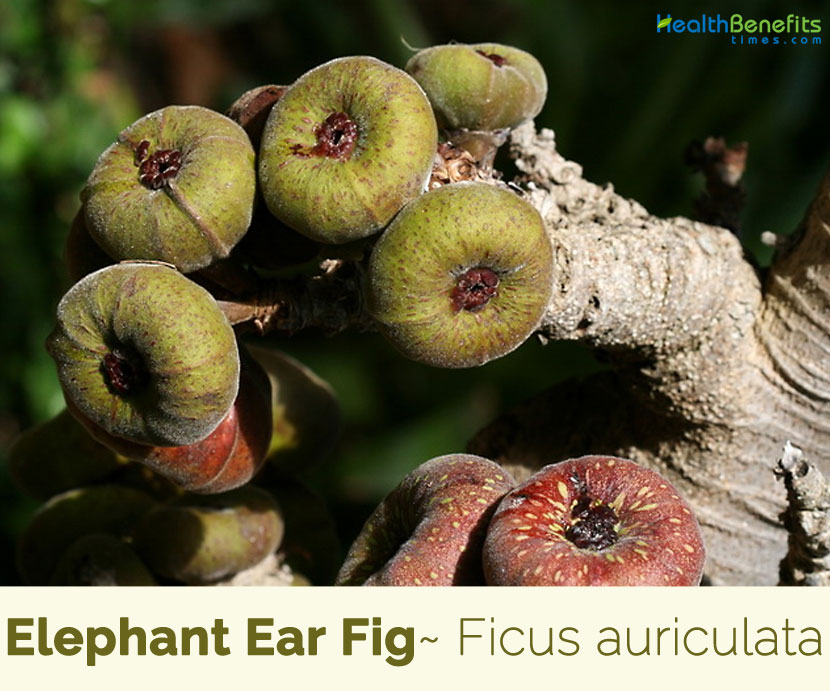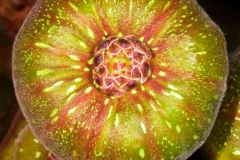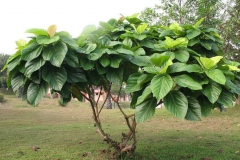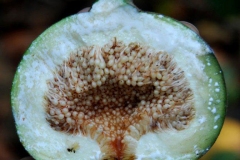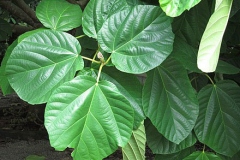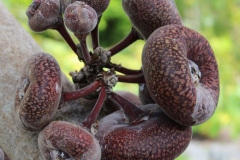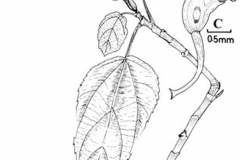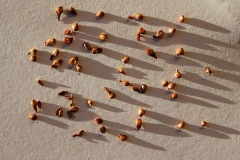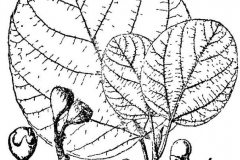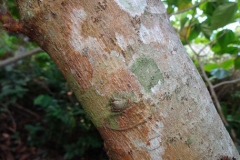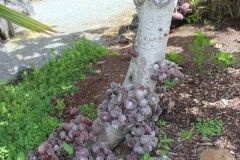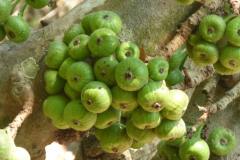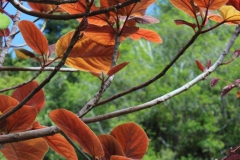Elephant Ear Fig Facts
| Elephant Ear Fig Quick Facts | |
|---|---|
| Name: | Elephant Ear Fig |
| Scientific Name: | Ficus auriculata |
| Origin | India, Bhutan, Nepal, Sikkim, Myanmar, Thailand, Vietnam, South China |
| Colors | Green, turning to brown to reddish brown when mature |
| Shapes | Depressed globose oblate, with 8–12 conspicuous longitudinal ridges, 3–6 cm in diameter |
| Health benefits | Beneficial for edema, wounds, diarrhea and dysentery, mumps, cholera, jaundice, diabetes, high blood pressure, constipation, enhance sexual abilities, strengthen bones |
| Name | Elephant Ear Fig |
|---|---|
| Scientific Name | Ficus auriculata |
| Native | India (Himalaya region), Bhutan, Nepal, Sikkim, Myanmar, Thailand, Vietnam, South China (South Guangdong, Guangxi, South West Guizhou, Hainan, South West Sichuan, Yunnan) |
| Common Names | Broadleaf Fig, Coconut-Strawberry Fig, Elephant Ear Fig Tree, Eve’s Apron, Giant Indian Fig, Indian Big Leaf Fig, Roxburgh Fig, eared strangler fig, Himalaya fig tree, imperial tree |
| Name in Other Languages | Arabic: Tayn ‘adhini (تين أذيني) Assamese: Altha Dimoru,Mon dimoru,Atha-dimoru, atha dimoru (আঠা ডিমৰু), mau dimoru (মৌ ডিমৰু) Bengali: Demur, Doomoor Brazil: Figueira da India Burmese: Lagum, Na gum, Sin thapan, Taba, Thu hpak lu sang, Demur Chinese: Da guo rong (大 果榕), ping Guo Rong Dimasa: Thaibor English: Eve’s apron, Roxburgh fig, Elephant ear fig, Himalayan fig, imperial tree Finnish: Elefanttiviikuna French: Figuier de l’Himalaya Garo: Thebol German: Roxburgh-Feige, Himalaja-Feigenbaum Hebrew: פיקוס אוזני Hindi: Gular, Timbal, Timal, Timla, Tirmal, Tremal, Trimmal, phagoora, fagoora, tiamble, tunla, फागूड़ा phagoora Indonesia : Terentang Langit Japanese: Oobai chijiku (オオバイチジク) Kannada: Anjoora (ಅಂಜೂರ), seeme atthi (ಸೀಮೆ ಅತ್ತಿ) Karbi: Lothepi Malaysia : Kalebok, Nangtan, Pelir Musang Malayalam: Valiya atti (വലിയ അത്തി), aanachcheviyan aththi (ആന ചെവിയൻ അത്തി), thontippazham (തൊണ്ടിപ്പഴം) Manipuri: Heiba Marathi: Deshi anjir (देशी अंजीर) Mishing: Kukbal Takuk Mizoram: Theibal Nepali: Karrekan, Nimaaro, Timiilo, Chanadumari (चाँदमुर्राई), nimaro (निमारो), timilo (तिमिलो) Portuguese: Figueira da India, figueira brava, Punjabi: Daduri, Timal, Trimbal, Trimal Spanish: Higuera de Roxburgh, Higuera del Himalaya Thai: Madeụ̄̀x h̄ŵā (มะเดื่อหว้า) Tulu: Anjoora parandu (ಅಂಜೂರ ಪರಂದು) Vietnamese: Cây vả, Vả |
| Plant Growth Habit | Evergreen to semi-deciduous, wide spreading, small tree |
| Growing Climates | Forests in moist valleys, or in midlands and mountainous areas, windbreaks of the forest, in forest clearings, or at the edge of rain forests |
| Soil | Thrives in loose, moist, friable soil, rich in organic matter |
| Plant Size | About 5–10 m (16–33 ft.) high with a stem diameter of 10–15 cm |
| Bark | Greyish brown, rough bark |
| Stipules | Reddish purple, triangular-ovate, 1.5–2 cm, adaxially shortly pubescent |
| Branches | Young branches are thin, reddish brown, pubescent, with the leaves concentrated in the terminal part. |
| Stem | Leafless in the middle of the stem and pubescent |
| Leaf | Alternate on thick, 8–15 cm long petiole and clustered towards the stem apex. Leaf blade is broadly ovate-cordate, large, 15–55 × 10–27 cm, thickly papery, abaxially pubescent, adaxially glabrous or puberulent on mid vein or secondary veins, base cordate or rounded, margin regularly shallowly dentate |
| Flowering season | First week of March and continues till the end of April |
| Flower | Both the male and female flowers are borne on the fleshy receptacle. The male flowers are 4 mm long and the female flowers are 6 mm long. Calyx and the corolla are modified into threadlike scales |
| Fruit Shape & Size | Depressed globose oblate, with 8–12 conspicuous longitudinal ridges, 3–6 cm in diameter, white, shortly pubescent when young |
| Fruit Color | Green, turning to brown to reddish brown and glabrescent when mature |
| Propagation | Woody stem cuttings or air-layering |
| Season | First week of June to the end of July |
Plant Description
Elephant Ear Fig is an evergreen to semi-deciduous, wide spreading, small tree that normally grows about 5–10 m (16–33 ft.) high with a stem diameter of 10–15 cm. The plant is found growing in forests in moist valleys, in midlands and mountainous areas, windbreaks of the forest, in forest clearings, or at the edge of rain forests. The plant thrives in loose, moist, friable soil, rich in organic matter. Bark is greyish brown and rough. Young branches are thin, reddish brown, pubescent, with the leaves concentrated in the terminal part. Stipules are reddish purple, triangular-ovate, 1.5–2 cm, adaxially shortly pubescent. The plant is leafless in the middle of the stem and is pubescent.
Leaves
Leaves are alternate on thick, 8–15 cm long petiole and are clustered towards the stem apex. Leaf blade is broadly ovate-cordate, large, 15–55 cm long and 10–27 cm wide, thickly papery, abaxially pubescent, adaxially glabrous or puberulent on mid vein or secondary veins, base cordate or rounded, margin regularly shallowly dentate, apex obtuse and mucronate. Basal lateral veins 4–6, secondary veins 3 or 4 on each side of mid vein. It is papery, densely small tuberculate on the underside and hairless above. The young leaves are intensely red, and turn more and greener till they reach their ultimate size of up to 30-40 cm in diameter.
Flower
Flowers are unisexual. Inflorescence is hypanthodium; both the male and female flowers are borne on the fleshy receptacle. The male flowers are 4 mm long and the female flowers are 6 mm long. Calyx and the corolla are modified into threadlike scales. Stamens are very small, about 2 mm long, style is long, deeply two-branched and single, ovoid ovary. Flowering normally takes place from first week of March and continues till the end of April.
Fruits
Fertile flowers are followed by cluster of figs on short branchlets of old stems, sometimes even on the roots of the tree. They are pear-shaped to spherical, with 4-6 longitudinal ridges and small tubercles. They are 2-3.5 cm in diameter, covered with soft hairs. They are initially green, turning to brown or reddish brown and glabrescent when mature. The fruit is, in fact, a fleshy receptacle, enclosing a number of true fruits or achene’s, which develop from the female flowers lying within this receptacle. They are edible and sweet and are used to make jams, juices and curries in India. Unripe fruits are also used in Vietnam in salads. Leaves are used as fodder for ruminants.
Traditional uses and benefits of Elephant Ear Fig
- Mature fruit have digestive regulating properties and is diuretic and laxative in traditional medicine.
- Roots and leaves are used as antidote to poison and to reduce edema in Vietnam.
- Leaves are crushed and the paste is applied on the wounds in Nepal and India.
- Leaves and roasted figs are also used in treating diarrhea and dysentery.
- Stem bark juice is effective for diarrhea, cuts and wounds.
- Root latex is used in treating mumps, cholera, diarrhea and vomiting.
- Mixture of root powder of F. articulate and bark of Oroxylum indicum is taken in jaundice.
- Bark yields a coarse fiber and is used in the preparation of medicine for hydrophobia.
- The latex from the stems is applied to cuts and wounds.
- The fiber in fig fruit helps reduce weight.
- High concentration of fiber in fig fruit helps promote healthy, regular bowel function and prevents constipation.
- Soak 2-3 figs in milk overnight and eat them in the morning to enhance sexual abilities.
- Figs are rich in calcium, phosphorus, which strengthen bones.
- High potassium content in figs helps to prevent urinary calcium loss
- Infusion of leaves consumed in Malaysia to treat diabetes and high blood pressure.
- In Himachal Pradesh and in Northeastern India especially in Manipur, the leaves are traditionally used for the treatment of Diabetes.
- Latex from stem is widely used in cuts, wounds and effective for diarrhea.
- Leaf and fruit part is stated to have antibacterial, anti-inflammatory and antioxidant activities.
- Leaf paste is used to cure wounds.
- Roasted figs are taken for diarrhea and dysentery.
Culinary Uses
- Both ripe and near-ripe fruit are edible.
- Both peeled and unpeeled fruit are sold in the market in north and Central Vietnam.
- Near-ripe fruit is cut into slices and dried or sliced and diced into small bits in stir fried dishes in Vietnam particularly in Hue.
- Ripe fruit can be made into jams and curries.
- Young leaves are also eaten as vegetables in North Vietnam.
- In Northeast India, the fruits are eaten raw.
- Fruits are edible and are used to make jams, juices and curries in India.
- Unripe fruits are also used in Vietnam in salads.
- This fruit (technically called Syconus) is used as vegetable when green and eaten as fruit when ripe.
Other facts
- Ficus Auriculata is also an important tree fodder in the Himalayan region of Nepal and India.
- Its fodder quality is far superior to paddy straw, the main winter fodder in the rice growing regions of the Himalayas.
- Also planted as an ornamental landscape plant in large gardens and parks in Southeast Asia.
- Leaves are used as fodder for ruminants.
- Wasps play an important role in pollination and reproduction of this species.
- Ficus auriculata may be cultivated for erosion control.
- The leaves are also used as plates by stitching 3-4 leaves together for taking food during festive banquets in the villages of Nepal.
Precautions
- Exposure to juice or sap from these plants or a puncture wound from the thorns may produce a skin rash or irritation.
- Ingestion may cause minor symptoms such as rash, vomiting or diarrhea.
References:
https://www.itis.gov/servlet/SingleRpt/SingleRpt?search_topic=TSN&search_value=823734#null
https://npgsweb.ars-grin.gov/gringlobal/taxonomydetail.aspx?id=16777
https://plants.usda.gov/core/profile?symbol=FIAU3
http://www.narc.gov.jo/gringlobal/taxonomydetail.aspx?id=16777
https://gd.eppo.int/taxon/FIURO
https://www.monaconatureencyclopedia.com/ficus-auriculata/?lang=en
http://www.theplantlist.org/tpl1.1/record/kew-2809581
https://www.flowersofindia.net/catalog/slides/Elephant%20Ear%20Fig.html
https://indiabiodiversity.org/species/show/266603
https://www.feedipedia.org/node/612
http://tropical.theferns.info/viewtropical.php?id=Ficus+auriculata
https://uses.plantnet-project.org/en/Ficus_auriculata_(PROSEA)
https://en.wikipedia.org/wiki/Ficus_auriculata
https://davesgarden.com/guides/pf/go/59550/#b
https://www.projectnoah.org/spottings/1119456008


